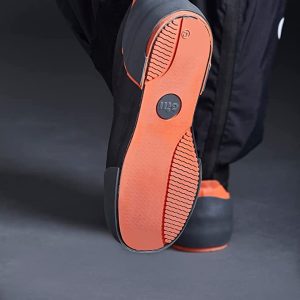While we all love comfortable shoes while sailing, sometimes the boat or the conditions demand a little more support or protection. Cold, wet feet make for cold bodies and bad traction. So whether you’re racing offshore, around the buoys in a dinghy, crossing oceans in a cruising boat, or even sailing home from a weekend when the weather turns bad, you’ll want the extra warmth, protection and dryness of a good set of boots.
What Makes a Good Sailing Boot?
What makes the difference between a boot serves you well and one that does not? Much depends on what type of boot you’re buying and how you’re sailing, but a few basics hold true for all boots.
Comfortable Fit
It’s got to fit you well without pinching or binding. And it can’t be too big, since that leads to unsure footing as your feet slide around inside.
For deck boots, make sure you can fit a pair of warm socks inside them, preferably a wool blend. Dinghy boots you’ll often wear with nothing under them, but if you are buying them for cold water sailing or frostbiting, you also need space for dry socks or a dry suit liner bootie.
 Gripping Sole
Gripping Sole
This could easily be the top criteria, because slick soled boots are worthless and dangerous. Look for a good grip no matter the boot. Even if you’re a dinghy sailor, you might need to stand up on the deck to fix something in the rig. A slick sole is a sure way to slip and hurt yourself.
Protection
While you don’t need a steel-toed boot, in bad conditions with water on the deck and poor visibility, you may well trip and stumble over deck hardware. It will still hurt, but a good boot will keep you from damaging your toes as you scurry around a pitching deck.
For dinghy boots, think about where they touch the boat. If you use a hiking strap, some reinforcement on the top of the boots goes a long way towards comfort on a long day of racing.
Breathability
Even in cold, wet conditions, if you’re working hard you’re going to sweat under your foulies, and that includes your boots. Not all boots will breathe, and heavy rubber sea boots will not. But it’s in the “nice to have” category since you may live in the boots for a while on an offshore passage.
Warmth/Insulation
For dinghy boots, warmth isn’t usually the first consideration unless you’re frostbiting in the winter. Most of them are neoprene, and trap and hold warm water like a wet suit.
Sea boots can offer thermal protection, and should keep your feet warm if the temperature drops.
 Water Management
Water Management
For sea boots offshore, water management means “keep it out”. They should have a high enough cut to overlap foul weather gear. Straps or ties to form a tight seal against the leg are a great feature.
Dinghy boats let water in, but also need to drain. You will be wet, and these boots are not for keeping you dry. They’re for protection and warmth, and they should not hold water beyond what they need for wetsuit function. Ankle seals can help this.
Construction and Material Quality
Like any shoe, boots and be glued, stitched, rubber welded, or some combination of all three techniques. Learn about the materials in the boot and how they’re assembled. Stitching usually gives the toughest construction, but it also puts holes in the rubber and makes leaky spots, so it’s not as common in 100% rubber boots.
Polyurethane boots are usually the least expensive and are not breathable. Natural rubber is more expensive, but softer and more comfortable. The addition of Gore-Tex, neoprene, and other advanced synthetics increase both the price and performance of the boots, but that’s what gives the breathability.
Ideally, you’ll have a combination of stitching and/or welding to give you a solid build with a waterproof covering.
Easy On/Off
Getting in and out of full foul weather gear on a pitching boat is a chore. When you’re scrambling topside in an emergency, you have little time to gear up for the weather. And your boots shouldn’t make it impossible. And you don’t want a struggle to get your gear off to visit the head or hit the berth off watch.
While a proper fit will keep them from being too hard to get off, the addition of grips, straps and other tools to help get them on is a big help. When loosened, ties and straps to for water tightness make it easier to get in and out of boots.
Try your boots on in your living room, where it’s warm, dry, and not moving. Then take them off again. Then try it wearing your foulies, PFD, and harness, because your boots go on after your pants. If you have any struggle in benign conditions, you may also struggle in the dark with unsure footing.
The Best Sailing Boots
- Top Offshore Cruising Sailing Boot – Gill Short Non-Slip Rubber Boot
- Best Dinghy Sailing Boot – Gill Edge 4mm Neoprene Boots
- Best Offshore Sailing Boot –Dubarry Ultima Mid-Calf Unisex Goretex Leather Sailing Boots
- All Around Dinghy Choice – GUL 2020 Spit Toe 5mm Power Boot
- Top Low-Cut Sailing Boot – XTRATUF Performance Series 6″ Men’s Full Rubber Ankle Deck Boots
- Breathable Offshore Boot – Gill Offshore Sailing Boot

